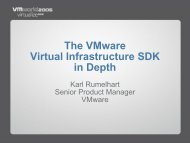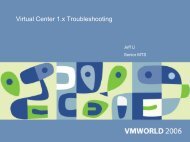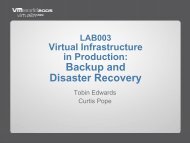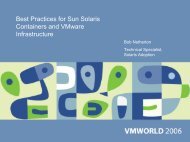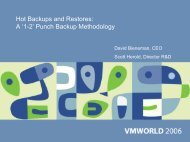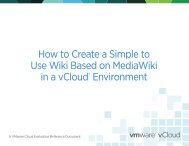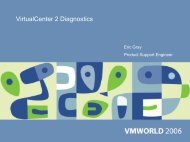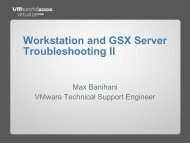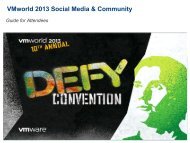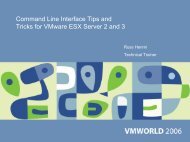Using VMware Community Source to Drive Innovation for ESX Server
Using VMware Community Source to Drive Innovation for ESX Server
Using VMware Community Source to Drive Innovation for ESX Server
You also want an ePaper? Increase the reach of your titles
YUMPU automatically turns print PDFs into web optimized ePapers that Google loves.
The World’s Leading Companies Rely On Emulex
Emulex Is Trusted World Wide<strong>Server</strong>s S<strong>to</strong>rage Partners
Downsides <strong>to</strong> Virtual <strong>Server</strong> SAN ConnectivityPrevious Single-System relationship <strong>to</strong> physical port lostThere is no VM-identification on any I/O request from the serverNo ability <strong>to</strong> differentiate VM-specific data flows in the fabric (QoS)Trouble-shooting issues with virtual machines more difficultS<strong>to</strong>rage Presentation very differentAll <strong>ESX</strong> servers must be able <strong>to</strong> see all s<strong>to</strong>rageOpen-Zoning – All servers and s<strong>to</strong>rage in same zoneLUN Mapping/Masking based on servers, not the machine• No ability <strong>to</strong> track per-VM data access on the s<strong>to</strong>rage arrayDepartmental division of “<strong>Server</strong>” admin vs “S<strong>to</strong>rage” admin blurred.
Emulex LightPulse Virtual HBAAllows a Virtual Machine <strong>to</strong> effectively have its own “SAN ID”Each VM has World Wide Port Name (WWPN) resourcesBased on industry standard N_Port_ID Virtualization (NPIV)Multiple SAN addresses assigned <strong>to</strong> a physical port and distributed <strong>to</strong> the VMsEnables SAN best practices:VM-based zoning and LUN masking/mapping <strong>to</strong> control presentationSAN <strong>to</strong>ols can track the Virtual MachineVirtualHWVirtualHWVirtualHWVirtualHWVirtualHWVirtualHWVirtualHWVirtualHWVirtualHWVirtualHWHypervisorHypervisorFibre Channel HBAWWNEmulex LightPulse Virtual HBA technologyMultiple FCIDs
The NPIV <strong>Community</strong> <strong>Source</strong> OpportunityNPIV requires modifications <strong>to</strong> more than the device driver<strong>ESX</strong> must know/manage WWPN’s as resources of the VMNPIV API between <strong>ESX</strong> and the driver is neededMust be integrated in<strong>to</strong> <strong>ESX</strong> at VM startup or shutdown.VMotion must migrate the NPIV resources along with the VM.<strong>ESX</strong> has significant design points <strong>to</strong> consider:Understanding “what could be” <strong>for</strong> dynamic resourcesEnsuring proper connectivity prior <strong>to</strong> VM startupHow <strong>to</strong> best create HA configurations<strong>Using</strong> <strong>Community</strong> <strong>Source</strong>, we can:Accelerate Development and integration in<strong>to</strong> <strong>ESX</strong>Use the <strong>for</strong>um <strong>for</strong> tighter communication with <strong>ESX</strong> engineering andproduct management
CS-NPIV ProjectEmulex created an Open Project <strong>to</strong> work on NPIV January 2006Includes Emulex and QLogicSVN branch on <strong>ESX</strong> 3.0 trunkEmail reflec<strong>to</strong>r <strong>for</strong> discussion and submit logsBi-Weekly Con CallsResults:Emulex-contributed API specification now an <strong>ESX</strong> interface<strong>VMware</strong> has integrated NPIV support in<strong>to</strong> CS <strong>ESX</strong> kernelNPIV Technology Preview released September 2006Set of rpms <strong>for</strong> <strong>ESX</strong> 3.0 <strong>to</strong> add NPIV supportInstallation of Emulex NPIV device driverUpcoming <strong>ESX</strong> releases folding in NPIV modifications
<strong>Community</strong> <strong>Source</strong> ImpressionsPositives:Ability <strong>to</strong> modify the kernel, not just your device driver.Able <strong>to</strong> gain deep understanding of <strong>ESX</strong> and how different parts interactAble <strong>to</strong> work directly with <strong>VMware</strong> engineers who concentrate on the vmwarekernelGreat ability <strong>to</strong> create changeCreate the solutionGenerate rpms <strong>to</strong> replace any or all kernel contentsAbility <strong>to</strong> immediately test, and <strong>to</strong> do so without <strong>VMware</strong> interactionVery good support documentation (lab notes and pdf docs)How <strong>to</strong> install; Lay down rpms; Build <strong>ESX</strong> server componentsTest Suites provided <strong>for</strong> many componentsGood Bug-Tracking <strong>to</strong>ols that can isolate view <strong>to</strong> a specific IHVExcellent Support teamKnowledgeable and responds quicklyProvides background testing supportOccasionally makes modifications on your behalf
<strong>Community</strong> <strong>Source</strong> ImpressionsCons:Applications and Management software is not part of CSIt is difficult <strong>to</strong> create applications <strong>to</strong> test your kernel APIsNo opportunity <strong>to</strong> aid in integrating change in<strong>to</strong> Virtual CenterDependent upon <strong>VMware</strong> <strong>for</strong> VC changesCS is still young and doesn’t enjoy wealth of IHV participation (yet)CS processes still going through growth processA lot of communication still occurs behind the scenesActual <strong>ESX</strong> integration, support levels, and schedules driven by <strong>VMware</strong>
<strong>Community</strong> <strong>Source</strong> vs Open <strong>Source</strong>Similarities:If you have the need, you can make it happenFull access <strong>to</strong> kernel code. Can see what it’s doing.Very good mailing lists used <strong>for</strong> help. Very knowledgeable residents on theselists.Differences (<strong>ESX</strong> vs Linux):<strong>ESX</strong>Single company managing processClear, quick acceptance process.Direct access <strong>to</strong> CS SVN poolKernel acceptance by <strong>VMware</strong>Small group of reviewersReview focused on End-User/ProductStrict compatibility requirementsVery Good Documentation and LabNotesLinuxEntities: The <strong>Community</strong>; each DistroAcceptance process cloudy. Kernelintegration multi-staged.Kernel acceptance by <strong>Community</strong> & DistroLarge community reviewMore focused on architectural purityMore amenable <strong>to</strong> API changeDocumentation scattered, perhaps out ofdate, not all inclusive. Some very good.
<strong>Community</strong> <strong>Source</strong> BenefitsTime <strong>to</strong> MarketCan significantly influence and accelerate change in <strong>ESX</strong>Ability <strong>to</strong> create asynchronous ISO imagesAbility <strong>to</strong> ship previews outside of <strong>VMware</strong> product delivery dates.• Ultimately, support is still based on <strong>VMware</strong> schedules
Tips and AdviceGet started earlyIdentify the technology and project and engage <strong>VMware</strong> teamUtilize the resources across the board<strong>VMware</strong> business, marketing, engineering and test resourcesUnderstand the optionsPrivate engagement, project group or CS-wideGet cus<strong>to</strong>mer validationUnderstand <strong>VMware</strong> cus<strong>to</strong>mer and your cus<strong>to</strong>mer overlapBe realisticRome wasn’t built in a day, and neither was <strong>ESX</strong>
Thank YouQuestions?
Presentation DownloadPlease remember <strong>to</strong> complete yoursession evaluation <strong>for</strong>mand return it <strong>to</strong> the room moni<strong>to</strong>rsas you exit the sessionThe presentation <strong>for</strong> this session can be downloaded athttp://www.vmware.com/vmtn/vmworld/sessions/Enter the following <strong>to</strong> download (case-sensitive):Username: cbv_repPassword: cbv<strong>for</strong>9v9r



